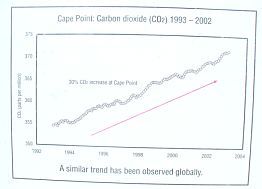No blog on life in London can ignore the threat of global warming for long. The topic consistently commands headlines here and across Europe. It dominates political debate, social commentary, and stories on business ethics. I don't recall global warning ever commanding such attention in Australia - other than occasional commentary on the Kyoto Accord. I guess Australians are used to hot, sunny weather and endless droughts.
By contrast, Europe appears obsessed with the impact of global warming. I must admit that I was skeptical about the hype when we first arrived in London. However, in recent times I've encountered compelling evidence about the reality of global warming. Evidence that carries added weight simply because it appears in the oddest of places.
Take, for example, the discovery I made at Cape Point last weekend. In this wind-swept corner of the globe lies a global atmosphere watch (GAW) station. It's part of a network of 20 stations worldwide, managed by the World Meteorological Organisation. The network includes stations at the South Pole and mainland Europe.
The Cape Point station has a small public display summarising its day-to-day work. I learned that the site monitors trace gases like ozone, methane and carbon dioxide, as well as solar radiation and various meteorological measures. Having visited the Cape Peninsular twice now I can safely say that the air is incredibly clear and persistent winds blowing in from Antartica keep the area free of pollutants.
As a result, it's an ideal location to measure atmospheric changes. I'd believe any measurement taken here. This has to be one of the world's cleanest locations. You can't imagine samples being corrupted by contaminants from Cape Town, Los Angeles or the urban world in general. In other words, trends measured at Cape Point must represent baseline numbers for the planet as a whole.
At regular intervals throughout the day the station samples the atmosphere at two points; one 30 metres above the ground, another at five metres. The captured sample is analysed and the results are transmitted automatically to a series of global databases. I was staggered to learn that the station has been reporting a steady increase in CO2 atmospheric gas levels for more than a decade.
The reality of global warming hits home when you see an uncontaminated site track with such clear and irrefutable evidence. CO2 levels really are rising in our planet's atmosphere. For the first time since arriving in Europe, I actually believe what I'm reading. I trust Al Gore's popular slide show. I can see that the media hype is based on fact. A very sobering thought indeed.
The graph on display at Cape Point. The trend is hard to ignore.







2 comments:
Global warming is in the news quite a bit now. Our new "Australian of the Year" is very vocal on the subject so I'm sure we will hear a lot more about it before the year is out. On the other side there is also a lot of talk about the natural cooling and warming of the planet over the ages, but I'm sure all the industries and motor vehicles etc blowing all their dirty fumes into the atmosphere have a definite detrimental effect.
I agree that its difficult to say who or what is causing the current trends. Al Gore's documentary comments on the natural fluctuation of greenhouse gases in the atmosphere. He graphically shows how the current rise is dramatically higher than any fluctation recorded for more than 20,000 years. He makes a compelling argument.
Post a Comment